Investigations on the Frictional Hysteresis Effect of Multi-Leaf Journal Foil Bearing: Modeling, Predictions and Validations
Abstract
:1. Introduction
2. Modeling of MLJFB with Coulomb Frictions
2.1. Nonlinear Curve Beam Element of the Foil Leaf
2.2. Contact Constraints Inside MLJFB including Frictions
2.2.1. Frictional Foil–Foil Contact
- (1)
- Contact energy formulations for sticking contact nodes pair
- (2)
- Contact energy formulations for the sliding contact nodes pair
2.2.2. Foil-Bearing Sleeve Contact
2.2.3. Rotor–Foil Contact
2.3. Boundary Conditions of the Elastic Foil Leaves
2.4. Iteration Formula and Calculation Algorithms
2.4.1. Iteration Formula
2.4.2. Calculation Algorithms
3. Results and Discussions
3.1. Influences of Nonlinear Large Foil Deformation in MLJFB
3.2. Frictional Hysteresis Characteristics of MLJFB
3.2.1. Influence of the Friction Coefficient
3.2.2. Influence of Foil Leaf Boundary Conditions
3.2.3. Influence of the Foil Leaf Number
3.2.4. Influence of Bearing Radial Clearance
3.2.5. Influence of Foil Leaf Structural Parameters
- (1)
- Initial foil leaf radius
- (2)
- Foil leaf thickness
- (3)
- Foil overlapping ratio
4. Experiments
5. Conclusions
- (1)
- The consideration of the geometrical nonlinearity of the larger foil deformation leads to the consistent results of foil assembly, rotor insertion and static loading under different initial foil configurations.
- (2)
- A fixed boundary of foil leaves can cause insufficient sliding motions between foil leaves and results in less dissipated energy by friction compared with hinged boundaries.
- (3)
- Under the same radial clearance, a larger foil leaf number, foil leaf thickness, initial foil leaf radius and foil overlapping ratio tend to increase the preload effect after rotor insertional assembly and result in a more compact and stiff foil structure. With a bearing size of 35 × 35 mm2, large values of the above parameters (Nf = 12, tf = 0.2 mm, Rf = 2.1 × Rr, λ = 0.45) can lead to the performance degeneration of the Coulomb friction energy dissipation. There are optimized values of these parameters, enabling the MLJFB to possess a larger area of frictional hysteresis loops.
- (4)
- A decreased radial clearance leads to insufficient foil deformations, thus reducing the frictional energy dissipation. A larger radial clearance can also result in less dissipated energy due to the limited rotor displacement by the rigid bearing sleeve under a larger static load.
Author Contributions
Funding
Data Availability Statement
Acknowledgments
Conflicts of Interest
Nomenclature
| Ba, BL, BN | total, linear and nonlinear strain matrix of the curve beam element |
| Cini | bearing radial clearance (m) |
| Dr | rotor diameter (m) |
| result vector after the variation calculation with respect to | |
| ey | rotor displacement in the y direction (μm) |
| Ea | total axial strain of the curve beam |
| En | geometrical nonlinear strain of the curve beam |
| Fy | bearing reaction force in the y direction or static bearing load (N) |
| normal contact gap between adjacent foils | |
| tangent contact gap between adjacent foils | |
| contact gap between the foil leaf and bearing sleeve | |
| contact gap between the rotor and foil leaf | |
| gap vector between adjacent foil leaves | |
| GU | general contact force vector |
| KU | general tangent matrix |
| bearing width (m) | |
| foil leaf length (m) | |
| , | unit normal and tangent vectors on the deformed contact surface |
| , | unit normal and tangent vectors of node A |
| general displacement vector per contact nodes pair | |
| Q | general displacement vector of all contact nodes pairs |
| , | unit normal and tangent vectors of interpolating node F |
| Nw, Nu | interpolating functions of the curve beam element at position |
| Nf | number of foil leaves |
| Rfa | inscribed circle radius after foil assembly (m) |
| Rs | inner radius of the bearing sleeve (m) |
| Rr | rotor radius (m) |
| Rf | free-foil radius (m) |
| s | position of the interpolating contact node on the master curve element |
| Sh | frictional hysteresis loop area (N·m) |
| tf | foil thickness (m) |
| displacement vector of the curve beam element | |
| w, v | radial and tangential displacements of the curve beam element (m) |
| ws | width of the foil installation groove (m) |
| flag of the sliding direction | |
| μ | friction coefficient between foil leaves |
| εs | elastic strain of the curve beam element |
| εt | penalty factor in the tangent direction |
| foil installation angle (°) | |
| threshold of the foil leaf rotating angle (rad) | |
| nodal rotational angle of the curve beam element (rad) | |
| foil overlapping ratio, | |
| Lagrange multiplier or contact force in the normal direction | |
| contact energy per contact nodes pair |
Appendix A
References
- Agrawal, G.L. Foil Air/Gas Bearing Technology—An Overview. In Asme International Gas Turbine & Aeroengine Congress & Exhibition; American Society of Mechanical Engineers: New York, NY, USA, 1997; Appendix. [Google Scholar]
- Pattnayak, M.R.; Ganai, P.; Pandey, R.K.; Dutt, J.K.; Fillon, M. An overview and assessment on aerodynamic journal bearings with important findings and scope for explorations. Tribol. Int. 2022, 174, 107778. [Google Scholar] [CrossRef]
- Heuer, D.F.; Collins, R.A. Dynamic and Environmental Evaluation of Compliant Foil Gas Lubricated Bearings; Air Force Aero Propulsion Laboratory, Air Force Systems Command, United States Air Force: Wright-Patterson Air Force Base, OH, USA, 1973.
- Koepsel, W.F. Gas Lubricated Foil Bearing Development for Advanced Turbomachines; Airesearch Mfg Co Of Arizona Phoenix: Phoenix, AZ, USA, 1977. [Google Scholar]
- Zorzi, E.S. Gas Lubricated Foil Bearing Development for Advanced Turbomachines, Volume II; Airesearch Mfg Co Of Arizona Phoenix: Phoenix, AZ, USA, 1977. [Google Scholar]
- Suriano, F.J. Gas Foil Bearing Development Program; Garrett Turbine Engine Co Phoenix Az: Phoenix, AZ, USA, 1981. [Google Scholar]
- Arakere, N.K.; Nelson, H.D. An analysis of gas-lubricated foil-journal bearings. Tribol. Trans. 1992, 35, 1–10. [Google Scholar] [CrossRef]
- Du, J.; Zhu, J.; Li, B.; Liu, D.; Song, C. The Effect of Area Contact on the Static Performance of Multileaf Foil Bearings. Tribol. Trans. 2015, 58, 592–601. [Google Scholar] [CrossRef]
- Li, C.; Du, J.; Zhu, J.; Yao, Y. Effects of structural parameters on the load carrying capacity of the multi-leaf gas foil journal bearing based on contact mechanics. Tribol. Int. 2018, 131, 318–331. [Google Scholar] [CrossRef]
- Iordanoff, I.; Hermel, P.; Stéfan, P. Surface contact in a symmetrical loading of a multileaf journal bearing. Tribol. Ser. 1993, 25, 169–177. [Google Scholar]
- Oh, K.P.; Rohde, S.M. A theoretical investigation of the multileaf journal bearing. ASME Trans. Ser. E J. Appl. Mech. 1976, 43, 237–242. [Google Scholar] [CrossRef]
- Heshmat, C.A. Heshmat H. An analysis of gas-lubricated, multileaf foil journal bearings with backing springs. ASME J. Tribol 1995, 117, 437–443. [Google Scholar] [CrossRef]
- Arakere, N.K. Analysis of foil journal bearings with backing springs. Tribol. Trans. 1996, 39, 208–214. [Google Scholar] [CrossRef]
- Haipeng, G.; Shemiao, Q.; Lie, Y.; Tiejun, W.; Min, H.; Shuhai, Y. The finite element simulation of the multi-leaf foil journal bearings with large assembly preload. In Proceedings of the 2009 IEEE International Conference on Mechatronics and Automation (ICMA), Changchun, China, 9–12 August 2009; pp. 3739–3744. [Google Scholar]
- Duan, W.; Sun, Y.; Geng, H.; Ding, C.; Yang, W.; Yu, L. Static performance of multi-leaf compliant Gas Foil Journal Bearings with assembly preload. In Proceedings of the 2013 IEEE International Conference on Mechatronics and Automation (ICMA), Takamatsu, Japan, 4–7 August 2013; pp. 681–685. [Google Scholar]
- Du, J.J.; Zhu, J.J.; Li, B.; Liu, D. Hydrodynamic analysis of multileaf gas foil bearing with backing springs. Proc. Inst. Mech. Eng. Part J J. Eng. Tribol. 2014, 228, 529–547. [Google Scholar] [CrossRef]
- Xu, B.; Zhong, J. Influence of contact friction on static characteristics of multileaf bump foil bearing. J. Phys. Conf. Ser. 2022, 2235, 012026. [Google Scholar]
- Reddy, D.S.K.; Swarnamani, S.; Prabhu, B.S. Analysis of aerodynamic multileaf foil journal bearings. Wear 1997, 209, 115–122. [Google Scholar] [CrossRef]
- Guo, Y.; Hou, Y.; Zhao, Q.; Ren, X.; Lai, T. Application of multi-leaf foil bearings in high-speed turbo-machinery. J. Adv. Mech. Des. Syst. Manuf. 2020, 14, JAMDSM0085. [Google Scholar] [CrossRef]
- Schmiedeke, H.; Sinapius, M.; Prechavut, N. Experimental Investigation of the Leaf Type Bearing Structure with Undersprings Under Dynamic Excitation. Machines 2021, 9, 15. [Google Scholar] [CrossRef]
- Roger Ku, C.-P. Hooshang Heshmat. Structural Stiffness and Coulomb Damping in Compliant Foil Journal Bearings: Theoretical Considerations. Tribol. Trans. 1994, 37, 525–533. [Google Scholar]
- Arghir, M.; Benchekroun, O. A simplified structural model of bump-type foil bearings based on contact mechanics including gaps and friction. Tribol. Int. 2019, 134, 129–144. [Google Scholar] [CrossRef]
- Xu, Z.; Li, C.; Du, J. Modeling and static characteristics study of the double-layer bump gas foil bearing. Tribol. Int. 2021, 164, 107202. [Google Scholar] [CrossRef]
- Yongpeng, G.U.; Lan, X.; Ren, G.; Zhou, M. An efficient three-dimensional foil structure model for bump-type gas foil bearings considering friction. Friction 2021, 9, 1450–1463. [Google Scholar]
- Zhao, X.; Xiao, S. A Finite Element Model for Static Performance Analysis of Gas Foil Bearings Based on Frictional Contacts. Tribol. Trans. 2021, 64, 275–286. [Google Scholar]
- Mahner, M.; Li, P.; Lehn, A.; Schweizer, B. Numerical and Experimental Investigations on Preload Effects in Air Foil Journal Bearings. ASME. J. Eng. Gas Turbines Power 2018, 140, 032505. [Google Scholar] [CrossRef]
- Larsen, J.S.; Varela, A.C.; Santos, I.F. Numerical and experimental investigation of bump foil mechanical behavior. Tribol. Int. 2014, 74, 46–56. [Google Scholar] [CrossRef] [Green Version]
- Feng, K.; Guo, Z. Prediction of Dynamic Characteristics of a Bump-Type Foil Bearing Structure with Consideration of Dynamic Friction. Tribol. Trans. 2014, 57, 230–241. [Google Scholar] [CrossRef]
- Zywica, G.; Baginski, P.; Bogulicz, M.; Martowicz, A.; Roemer, J.; Kantor, S. Numerical identification of the dynamic characteristics of a nonlinear foil bearing structure: Effect of the excitation force amplitude and the assembly preload. J. Sound Vib. 2022, 520, 116663. [Google Scholar] [CrossRef]
- Li, C.; Du, J.; Yao, Y. Modeling of a multi-layer foil gas thrust bearing and its load carrying mechanism study. Tribol. Int. 2017, 114, 172–185. [Google Scholar] [CrossRef]
- Li, C.; Du, J.; Yao, Y. Study of load carrying mechanism of a novel three-pad gas foil bearing with multiple sliding beams. Mech. Syst. Signal Processing 2020, 135, 106372. [Google Scholar] [CrossRef]
- Li, C.; Du, J.; Li, J.; Xu, Z.; Zhao, C. Investigations on the Load Capacity of Multi-layer Foil Thrust Bearing Based on an Updated Complete Model. ASME. J. Tribol. 2022, 1–20. [Google Scholar] [CrossRef]
- Zienkiewicz, O.C.; Taylor, R.L.; Fox, D. The Finite Element Method for Solid and Structural Mechanics; Butterworth-heinemann: Oxford, UK, 2005. [Google Scholar]
- Ashwell, D.G. Finite Elements for Thin Shells and Curved Members; Wiley: Hoboken, NJ, USA, 1976. [Google Scholar]
- Wriggers, P. Computational Contact Mechanics; Springer Science & Business Media: Berlin/Heidelberg, Germany, 2006. [Google Scholar]

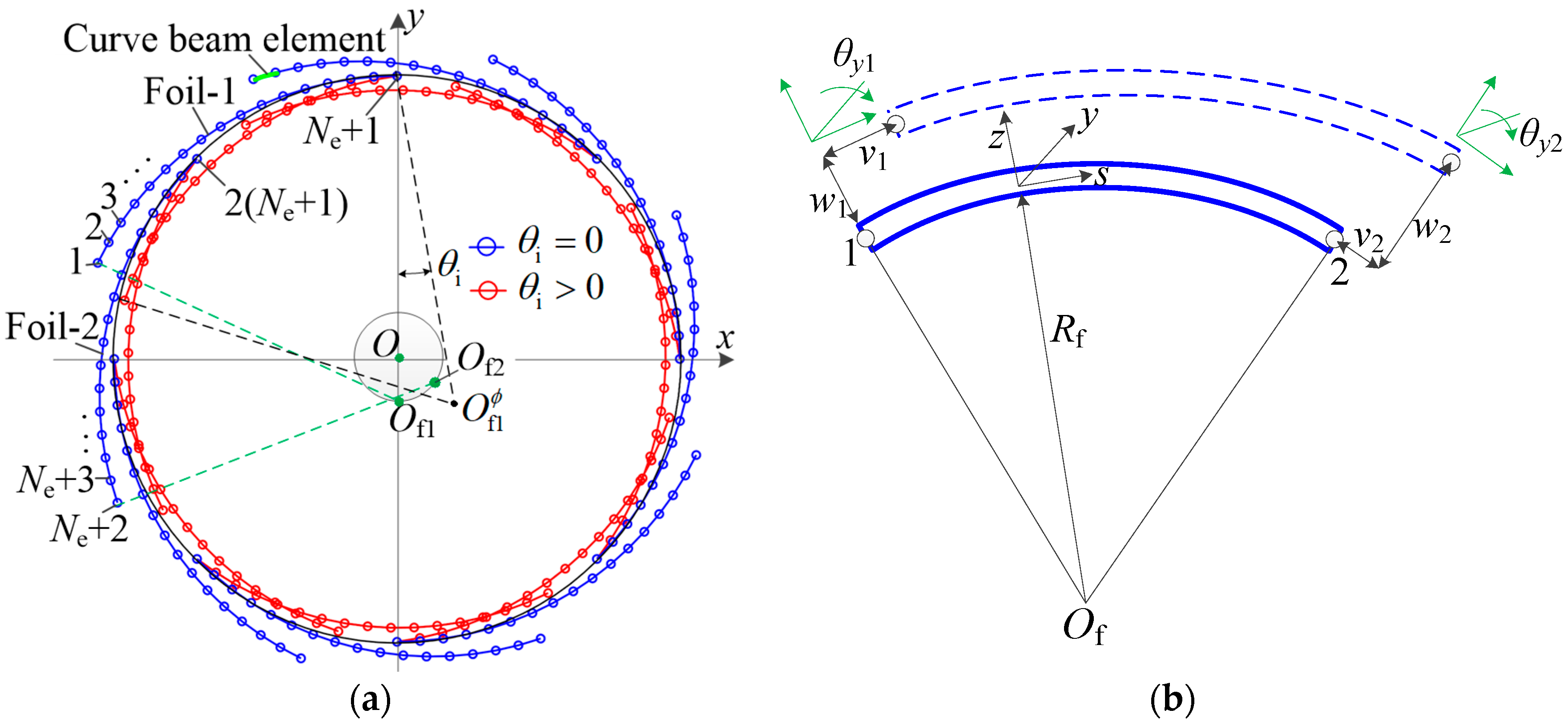
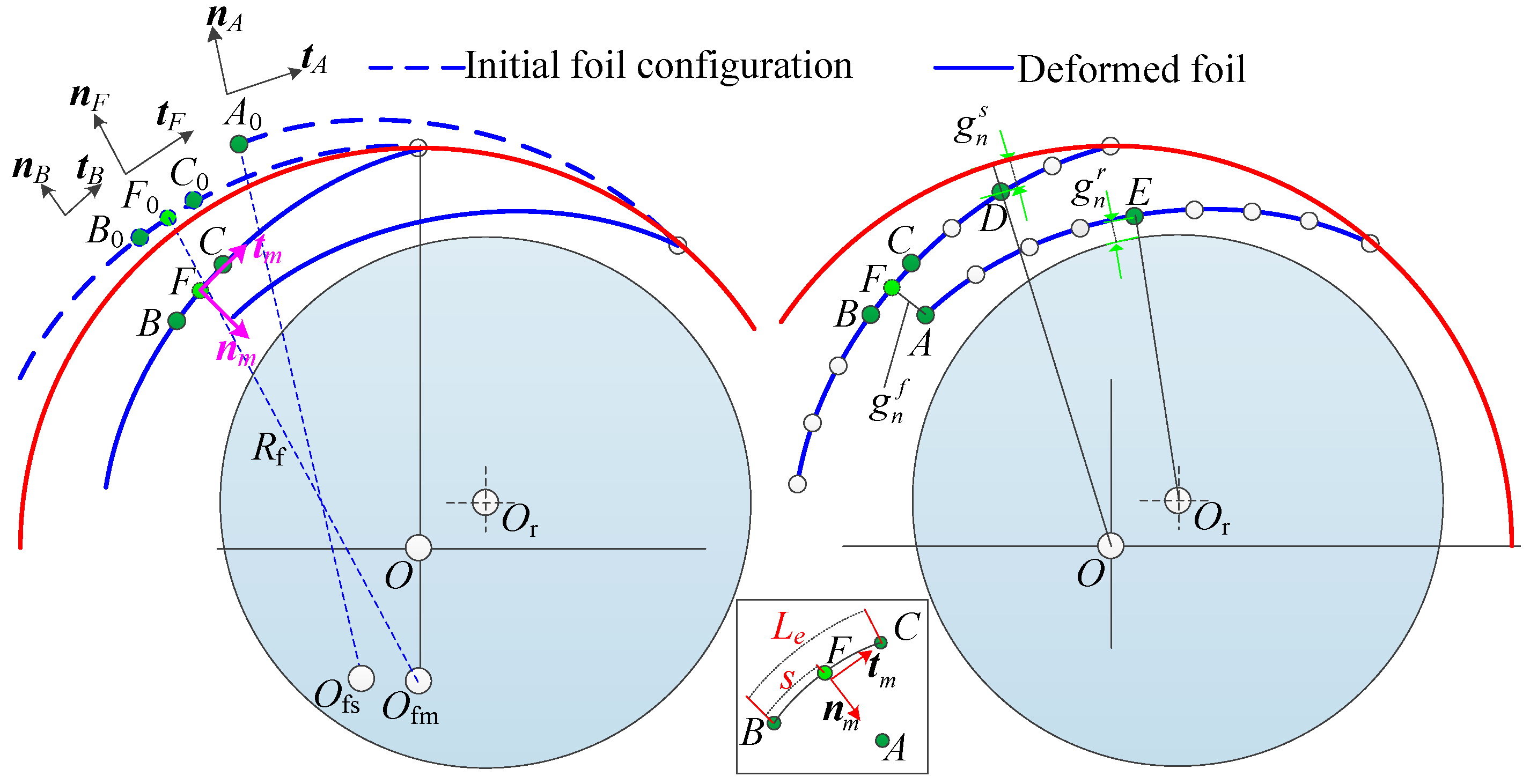

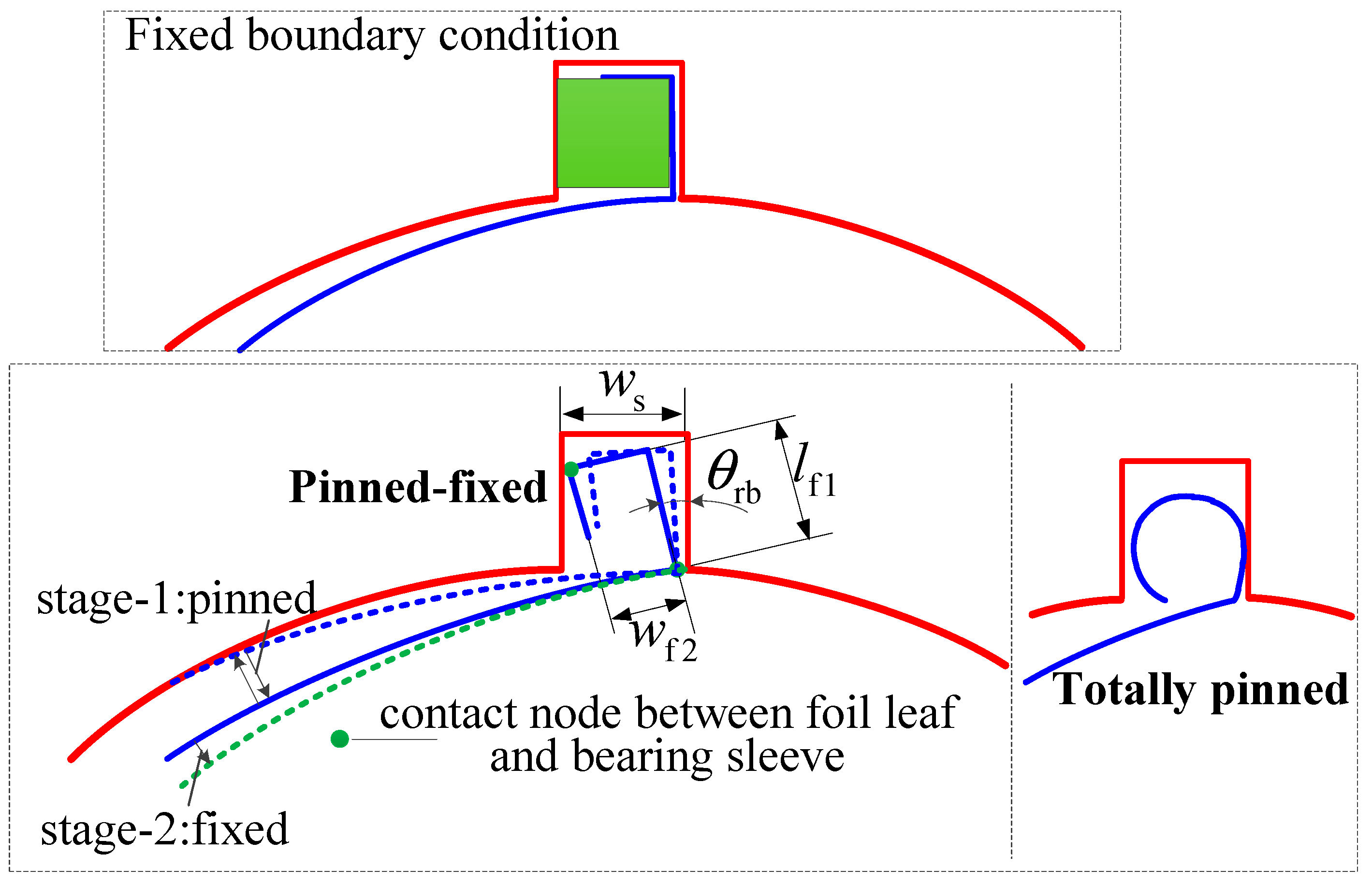
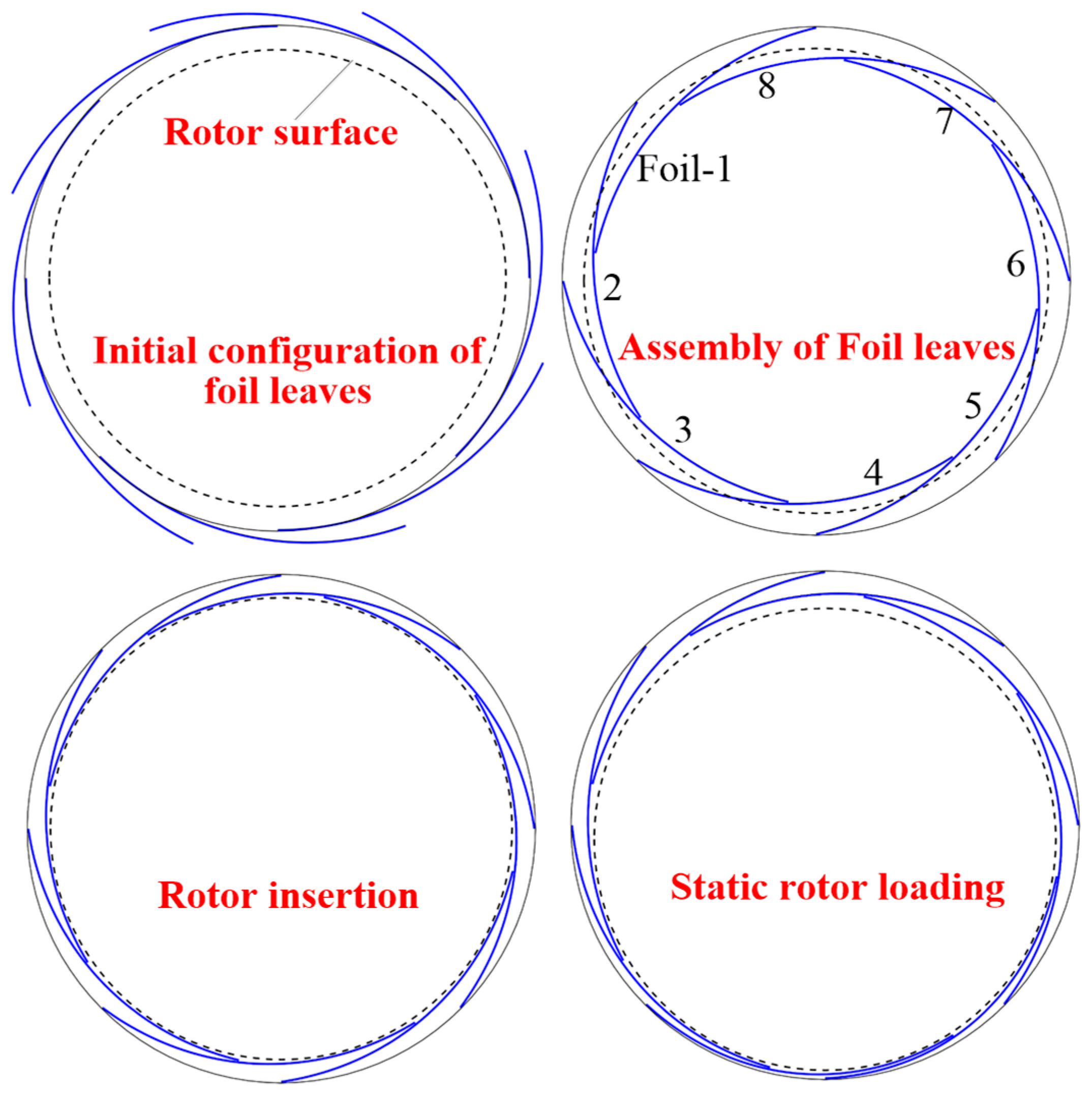


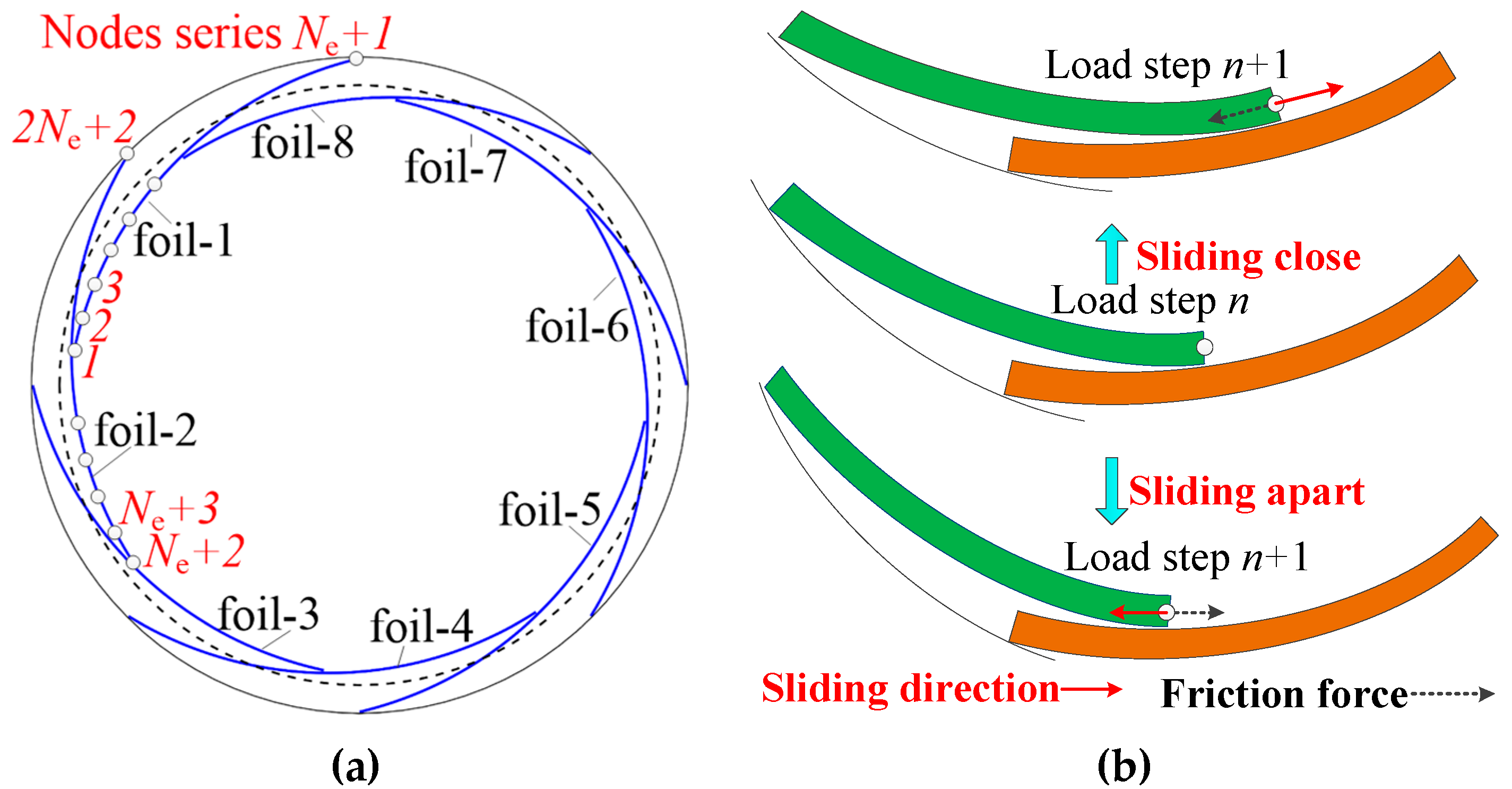
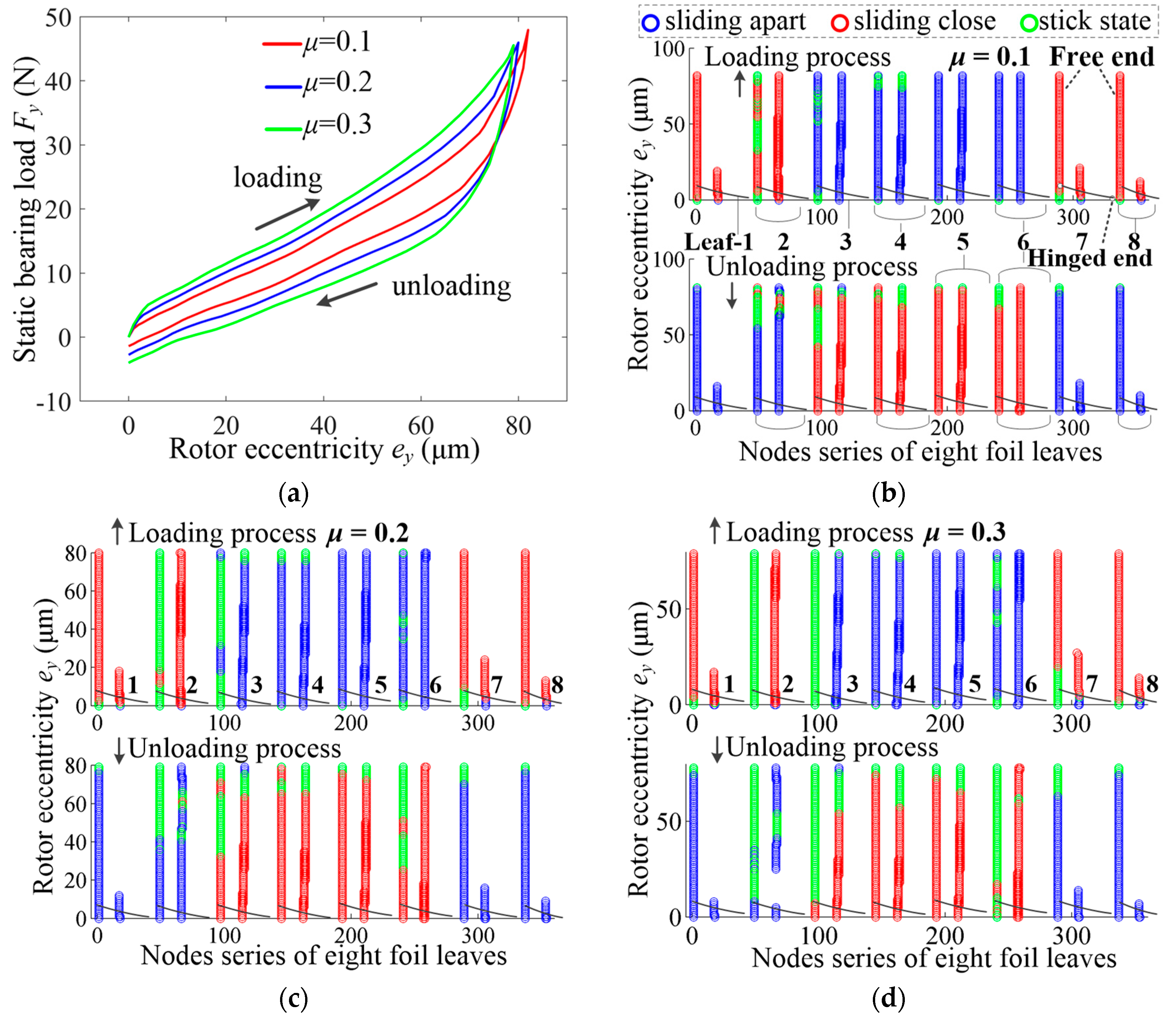
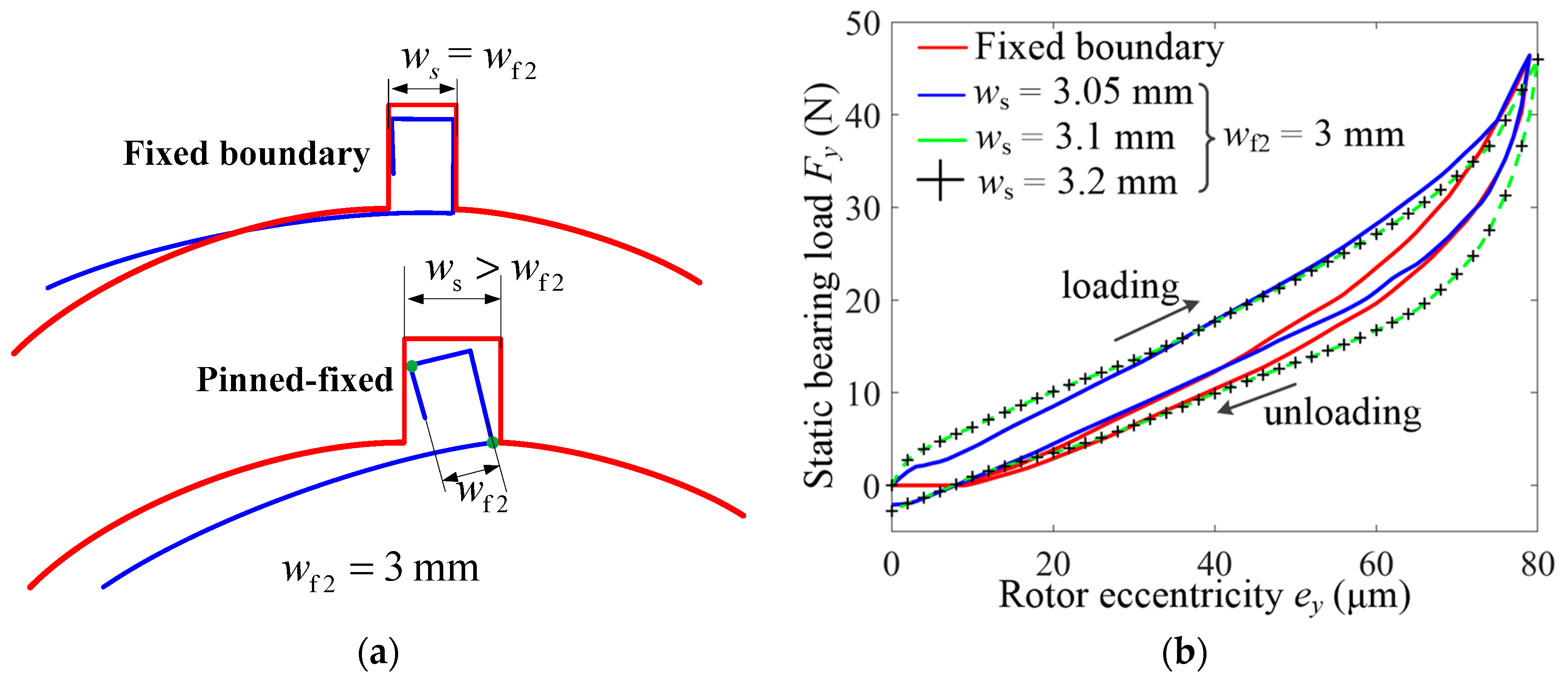
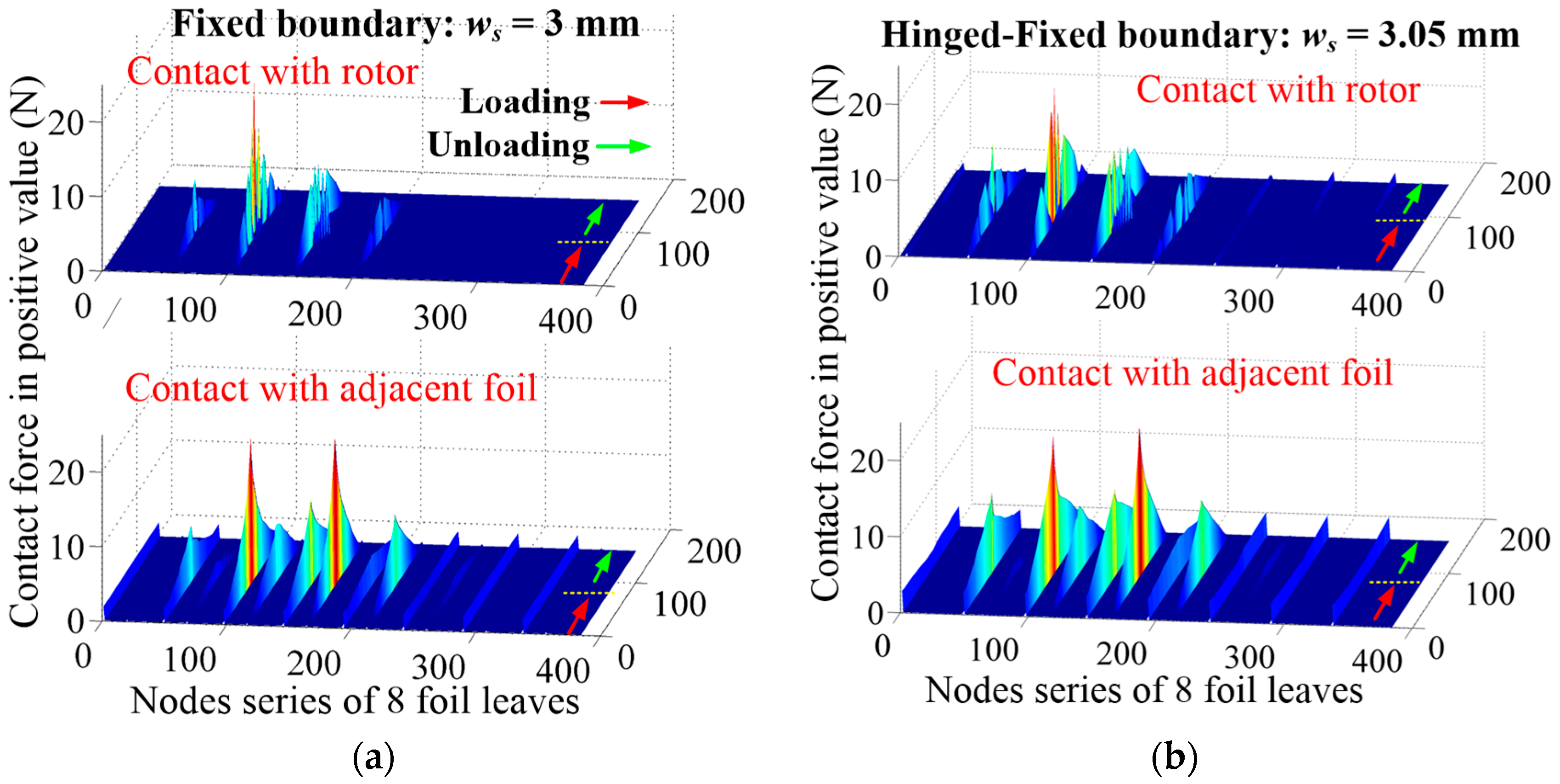



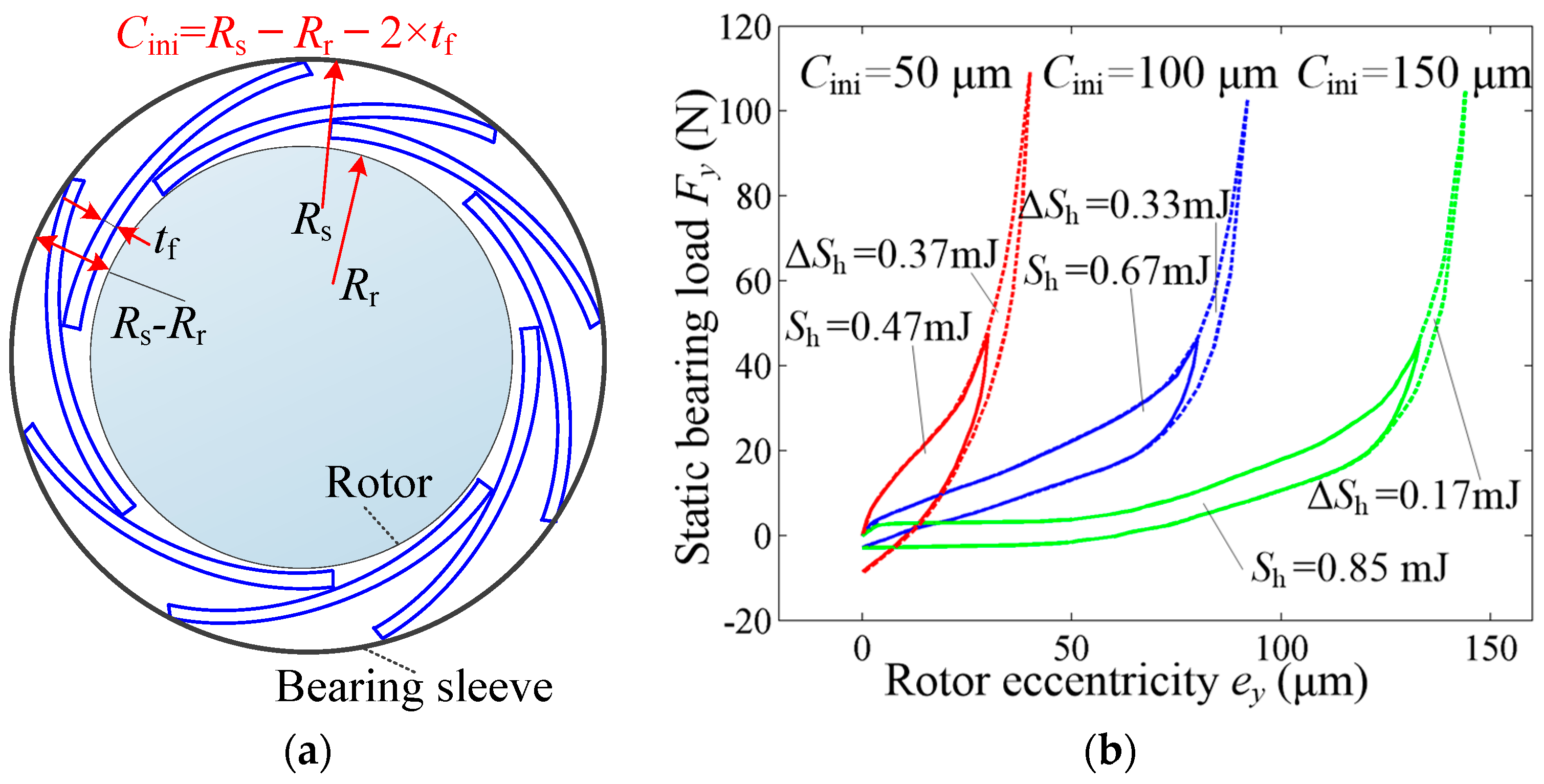
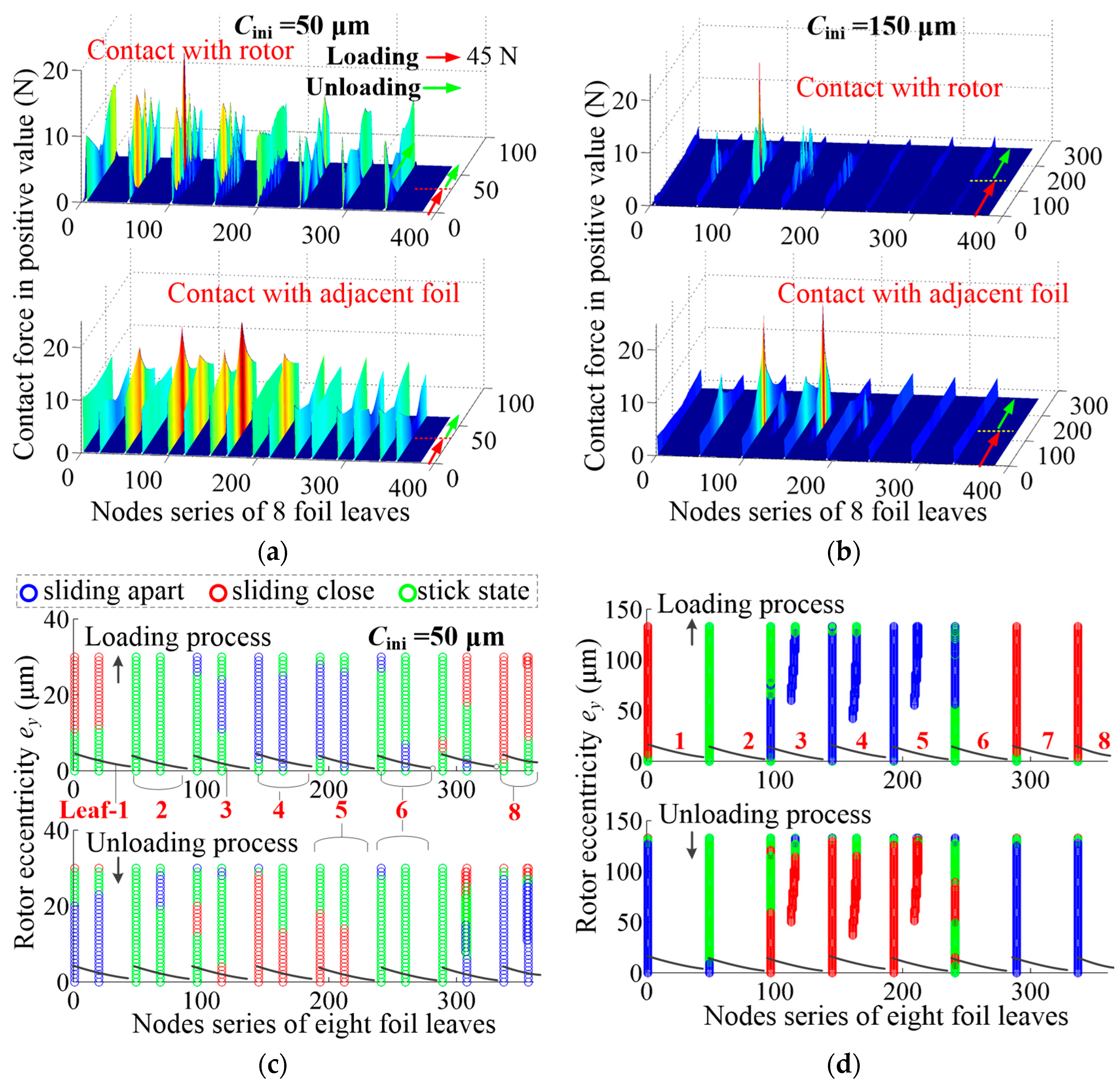
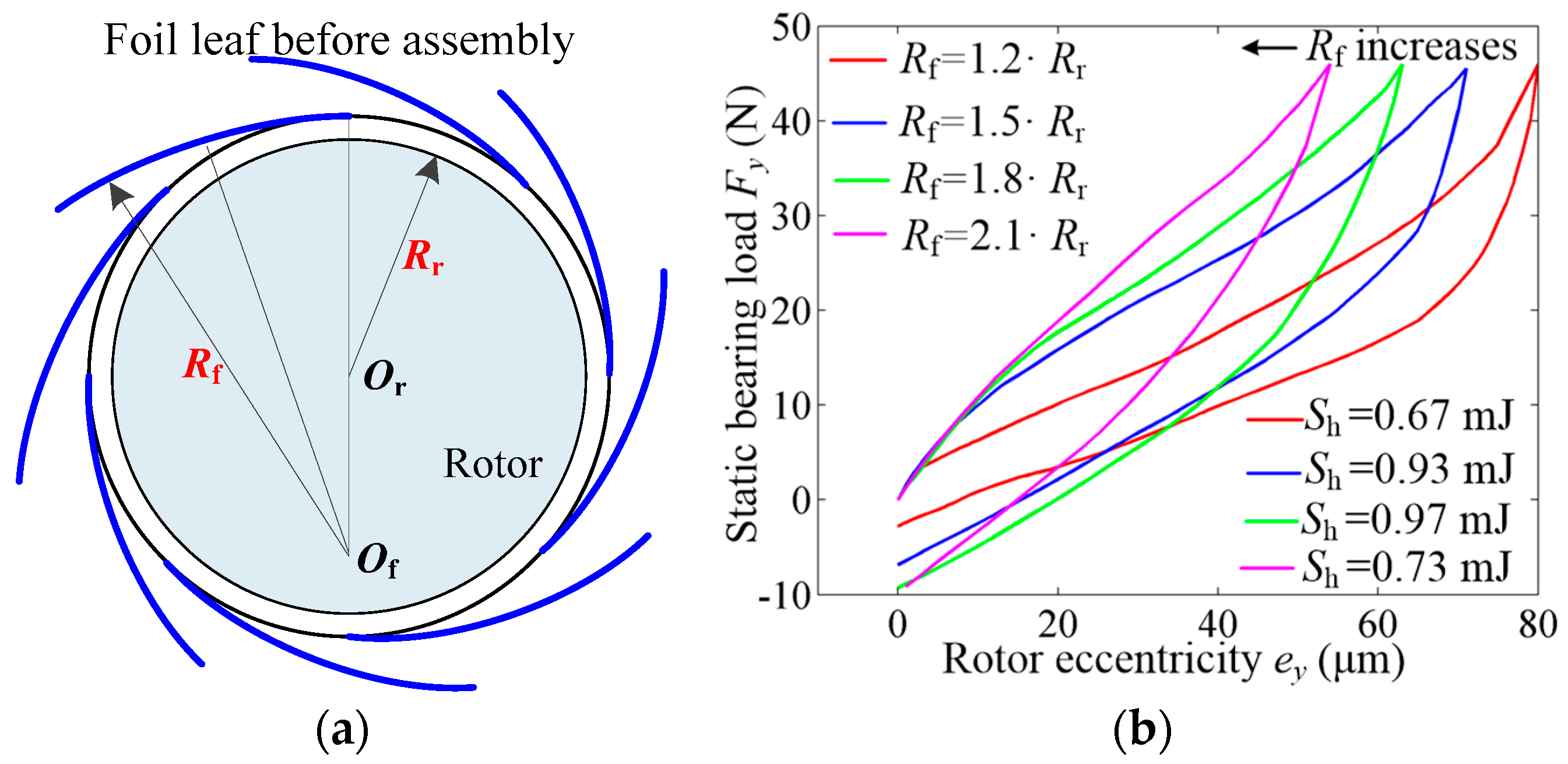

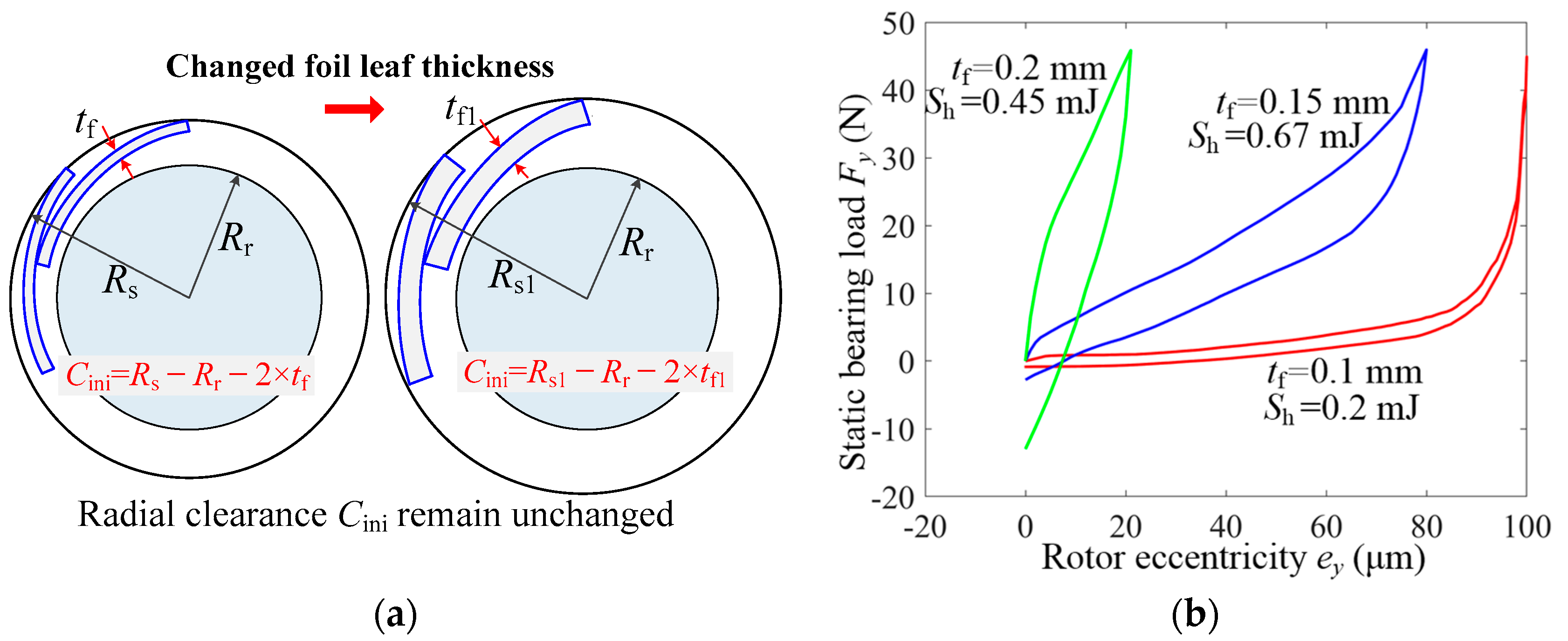
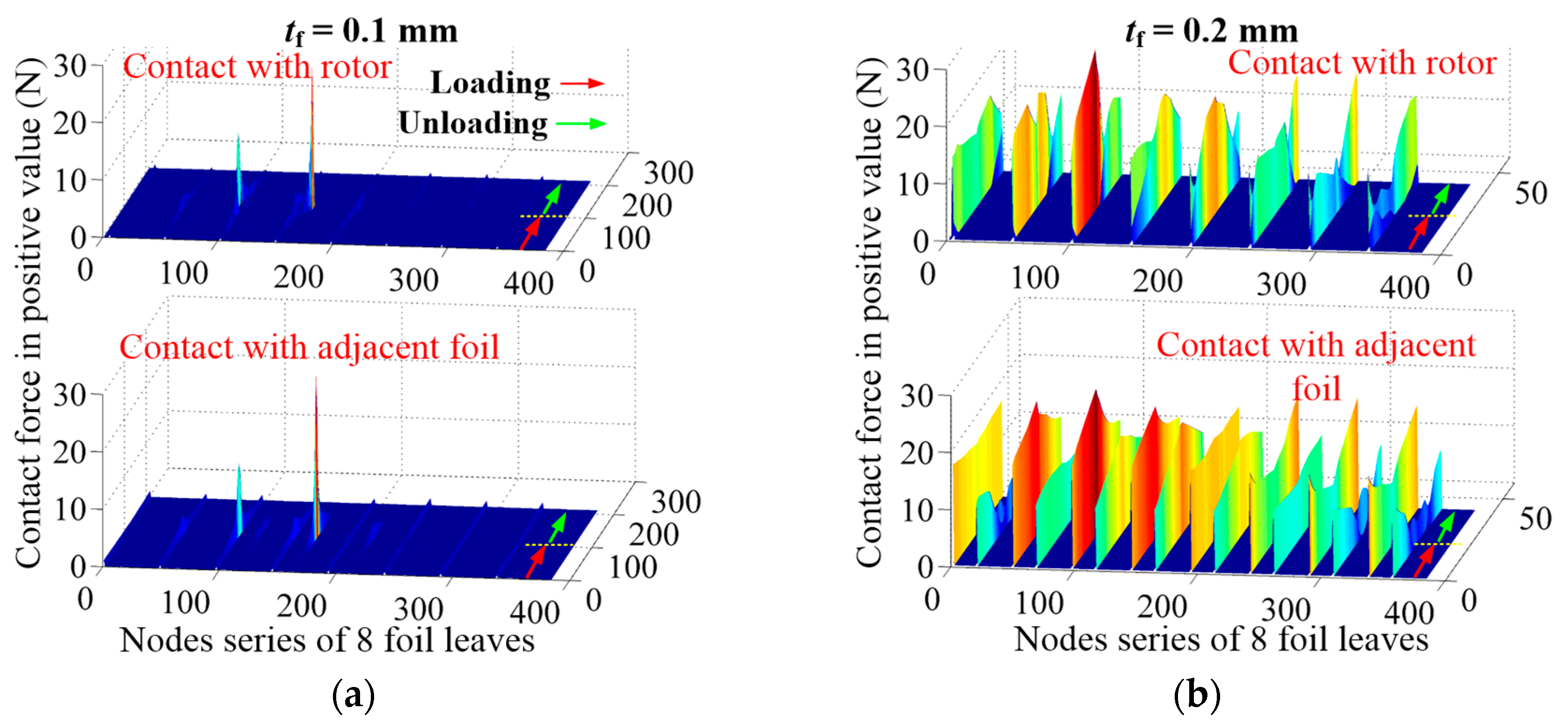

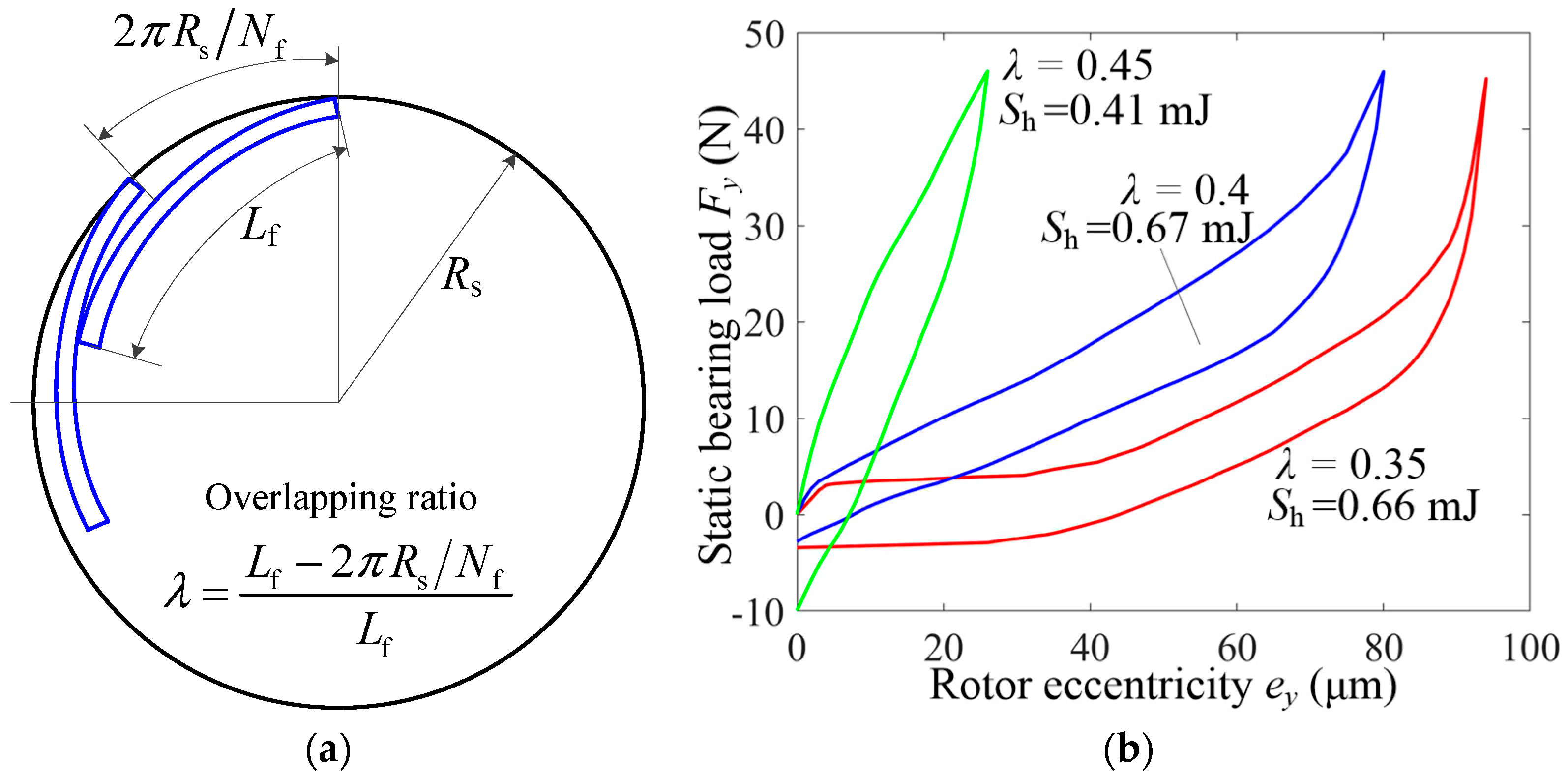
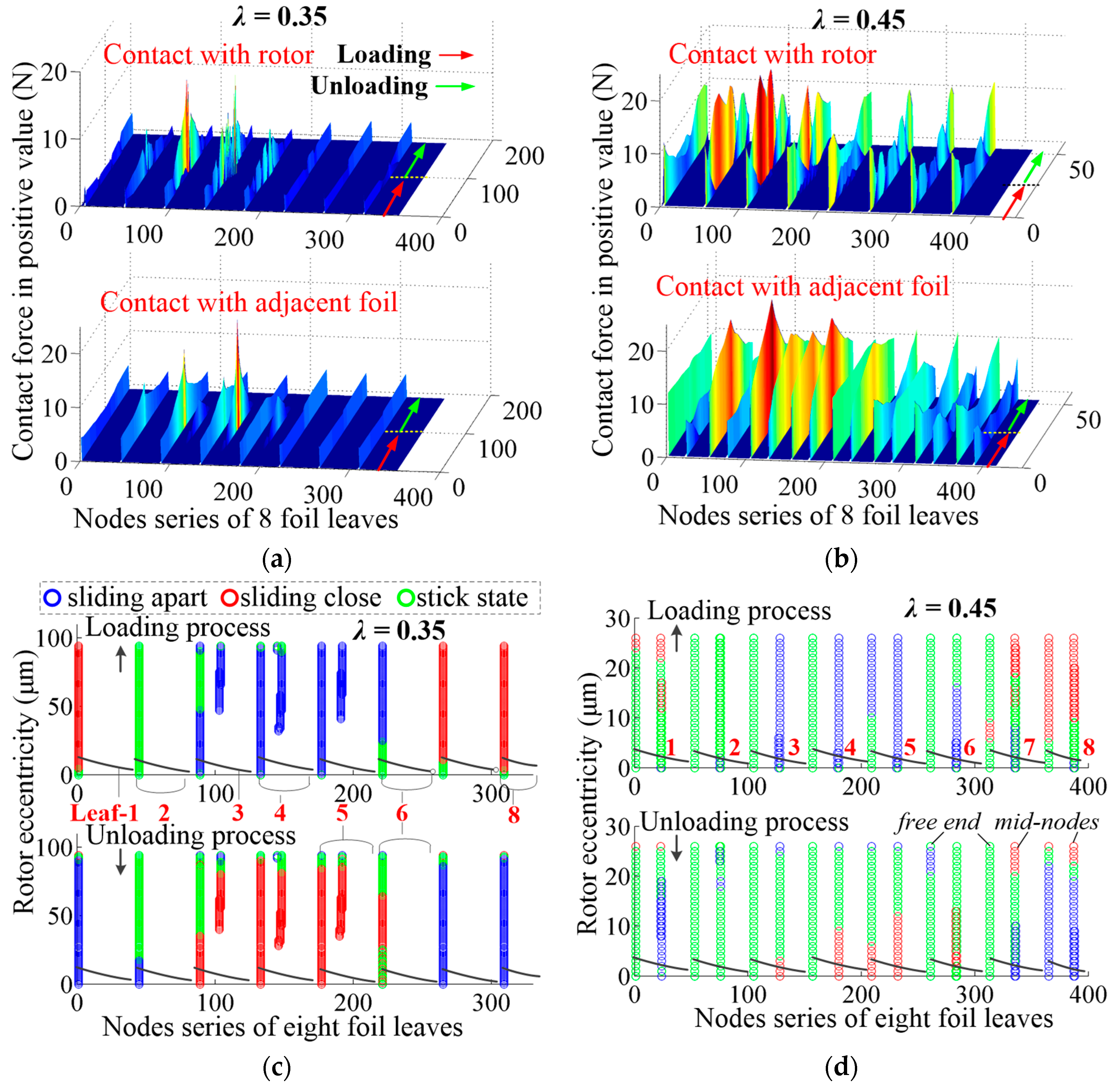



| Parameters | Values |
|---|---|
| Rotor diameter Dr/mm | 35 |
| Rotor radius Rr/mm | 17.5 |
| Bearing width L/mm | 35 |
| Foil leaf number | 5, 8, 12 |
| Foil leaf radius Rb/mm | 1.2 × Rr, 1.5 × Rr, 1.8 × Rr, 2.1 × Rr |
| Foil leaf thickness tf/mm | 0.1, 0.15, 0.2 |
| Overlapping ratio λ | 0.35, 0.4, 0.45 |
| Initial radial clearance Cini/μm | 50, 100, 150, 200 |
| Friction coefficient between foil leaves μ | 0, 0.1, 0.2, 0.3 |
Publisher’s Note: MDPI stays neutral with regard to jurisdictional claims in published maps and institutional affiliations. |
© 2022 by the authors. Licensee MDPI, Basel, Switzerland. This article is an open access article distributed under the terms and conditions of the Creative Commons Attribution (CC BY) license (https://creativecommons.org/licenses/by/4.0/).
Share and Cite
Li, C.; Du, J.; Li, J.; Xu, Z. Investigations on the Frictional Hysteresis Effect of Multi-Leaf Journal Foil Bearing: Modeling, Predictions and Validations. Lubricants 2022, 10, 261. https://doi.org/10.3390/lubricants10100261
Li C, Du J, Li J, Xu Z. Investigations on the Frictional Hysteresis Effect of Multi-Leaf Journal Foil Bearing: Modeling, Predictions and Validations. Lubricants. 2022; 10(10):261. https://doi.org/10.3390/lubricants10100261
Chicago/Turabian StyleLi, Changlin, Jianjun Du, Jie Li, and Zhenni Xu. 2022. "Investigations on the Frictional Hysteresis Effect of Multi-Leaf Journal Foil Bearing: Modeling, Predictions and Validations" Lubricants 10, no. 10: 261. https://doi.org/10.3390/lubricants10100261




